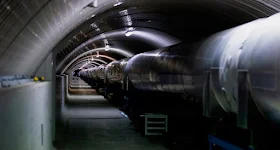This graphic shows
the data from each of the three observatories. The top graph shows the Signal
to Noise Ratio - or roughly how significant the detection was. The middle graph
shows the "chirp" or frequency shift across time. The bottom graph shows
the wave form. Credit: LIGO/Caltech/MIT/LSC
Σύμφωνα
με τον ιστότοπο ligo.caltech.edu στις 14 Αυγούστου 2017 ανιχνεύθηκε κι
άλλο βαρυτικό κύμα, το GW170814.
The animation shows
the coalescence of two orbiting black holes as detected by the Advanced LIGO
and Advanced Virgo observatories on the 14th of August 2017. The strength of
the gravitational wave is indicated by elevation as well as colour, with dark
green indicating weak fields and bright violet indicating strong fields. The
amplitude of the gravitational wave is rescaled in time which allows to show
the signal during the entire coalescence and not just close to merger, where it
is strongest. Additionally, the sizes of the black holes are increased by a
factor of two to improve visibility. © Numerical Simulation: S. Ossokine, A.
Buonanno (Max Planck Institute for Gravitational Physics), Simulating eXtreme
Spacetimes project; Scientific Visualisation: T. Dietrich (Max Planck Institute
for Gravitational Physics), R. Haas (NCSA)
Τελικά δεν προέρχεται από συγχώνευση άστρων
νετρονίων, αλλά από την συγχώνευση δυο μαύρων τρυπών με μάζες 31 και 25 φορές
την μάζα του Ήλιου. Η νέα μαύρη τρύπα που προέκυψε έχει μάζα 53 φορές την μάζα
του Ήλιου και βρίσκεται 1,9 δισεκατομμύρια έτη φωτός μακριά από την Γη.
With the Aug. 14
detection of spacetime ripples, scientists were able to home in on the location
of gravitational wave‒flinging black holes more precisely than ever before,
illustrated in lime green on a map of the sky. The regions associated with
three previous detections and an unconfirmed hint are shown for comparison. Credit:
LIGO/Caltech/MIT/Leo Singer (Milky Way image: Axel Mellinger)
Πρόκειται
για το πρώτο βαρυτικό κύμα που ανιχνεύθηκε και από τους τρεις ανιχνευτές, LIGO (Hanford),
LIGO (Livingston) και Virgo. Υπενθυμίζεται ότι ο ανιχνευτής Virgo μπήκε σε
λειτουργία στην 1η Αυγούστου 2017.
Virgo’s detector in
Italy joined the two U.S.-based LIGO detectors in the hunt for gravitational
ripples. Virgo consists of two 3-kilometer arms (one shown) through which laser
light bounces back and forth to search for the stretching and squeezing of
spacetime. © CYRIL FRESILLON/VIRGO/CNRS PHOTOTHÈQUE
Η
συμμετοχή του Virgo στην ανίχνευση των βαρυτικών κυμάτων βελτίωσε θεαματικά τον
προσδιορισμό της θέσης του συμβάντος. Στο διάγραμμα που ακολουθεί βλέπουμε την
βελτίωση στον προσδιορισμό της θέσης που παράχθηκε το βαρυτικό κύμα GW170814
από την συμμετοχή του ανιχνευτή Virgo. Με κίτρινο χρώμα ο προσδιορισμός από το LIGO
– με πράσινο χρώμα ο προσδιορισμός θέσης όταν περιλαμβάνονται τα δεδομένα του
Virgo:
Μια
σημαντική ανακοίνωση σχετικά με τα βαρυτικά κύματα από τους ερευνητές των
ανιχνευτών LIGO και VIRGO μπορείτε να παρακολουθήσετε ΕΔΩ:
Tα
χαρακτηριστικά του βαρυτικού κύματος GW170814. This piece of paper
contains summarizes data about GW170814. Credit: LSC/Anuradha Gupta/Zoheyr Doctor
Πηγές: GW170814 : A three-detector
observation of gravitational waves from a binary black hole coalescence -
physicsgg





Δεν υπάρχουν σχόλια:
Δημοσίευση σχολίου